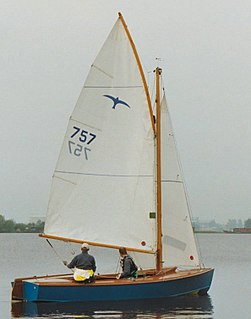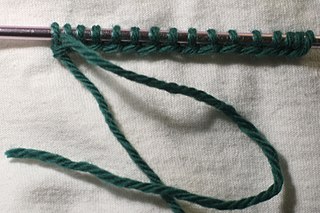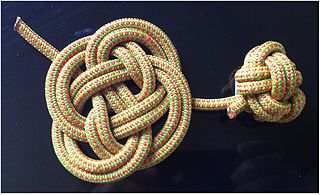

Halyard bend is a way to attach the end of a rope at right angle to a cylindrical object such as a beam.


Halyard bend is a way to attach the end of a rope at right angle to a cylindrical object such as a beam.
Halyard bend may be considered to be the "double-loop-around, and single-tuck-under" version of timber hitch which itself is usually tied as "single-loop-around, and double-tuck-under".

The timber hitch is a knot used to attach a single length of rope to a cylindrical object. Secure while tension is maintained, it is easily untied even after heavy loading.

A knot is an intentional complication in cordage which may be useful or decorative. Practical knots may be classified as hitches, bends, splices, or knots. A hitch fastens a rope to another object; a bend unites two rope ends; a splice is a multi-strand bend or loop. A knot in the strictest sense serves as a stopper or knob at the end of a rope to keep that end from slipping through a grommet or eye. Knots have excited interest since ancient times for their practical uses, as well as their topological intricacy, studied in the area of mathematics known as knot theory.

The bowline is an ancient and simple knot used to form a fixed "eye" at the end of a rope. It has the virtues of being both easy to tie and untie; most notably, it is easy to untie after being subjected to a load. The bowline is sometimes referred to as King of the knots because of its importance. Along with the sheet bend and the clove hitch, the bowline is often considered one of the most essential knots.

A miller's knot is a binding knot used to secure the opening of a sack or bag. Historically, large sacks often contained grains; thus the association of these knots with the miller's trade. Several knots are known interchangeably by these three names.

The constrictor knot is one of the most effective binding knots. Simple and secure, it is a harsh knot that can be difficult or impossible to untie once tightened. It is made similarly to a clove hitch but with one end passed under the other, forming an overhand knot under a riding turn. The double constrictor knot is an even more robust variation that features two riding turns.

The taut-line hitch is an adjustable loop knot for use on lines under tension. It is useful when the length of a line will need to be periodically adjusted in order to maintain tension. It is made by tying a rolling hitch around the standing part after passing around an anchor object. Tension is maintained by sliding the hitch to adjust size of the loop, thus changing the effective length of the standing part without retying the knot.

A Zeppelin bend is a general-purpose bend knot. It is a secure, easily tied, and jam-resistant way to connect two ropes. Though its simplicity and security may be matched by other bends, it is unique in the ease with which it is untied, even after heavy loading, by pulling the opposing bridges away from each other.

The anchor bend is a knot used for attaching a rope to a ring or similar termination. The name is a misnomer, as it is technically not a bend, but a hitch.

The draw hitch is a quick-release draw loop knot used for temporarily securing a load that will need to be released easily and cleanly. The hitch can be untied with a tug of the working end, even when under tension. The highwayman's hitch can be tied in the middle of a rope, and so the working end does not need to be passed around the anchor when tying or releasing.

In sailing, a gunter is used for two main configurations of rig:

A becket hitch, including the double becket or figure-of-eight becket hitch, is any hitch that is made on an eye loop, i.e. on a becket. A becket hitch has the same structure as the sheet bend, which joins, or "bends", the ends of two ropes together. The becket hitch, in contrast, fixes a rope to a closed eye or hook. In this instance, a becket means the eye or hook of a pulley block, an eye in the end of a rope, or a rope handle on a sailors sea chest.
English knitting, also known as right-hand knitting or throwing, is a style of Western knitting where the yarn to be knit into the fabric is carried in the right hand. This style is prevalent throughout the English-speaking world, though it is by no means universal.

The eye splice is a method of creating a permanent loop in the end of a rope by means of rope splicing.

In knitting, casting on is a family of techniques for adding new stitches that do not depend on earlier stitches, i.e., stitches having an independent lower edge. In principle, casting on is the opposite of binding off, but the techniques involved are generally unrelated.
In knitting, a yarn over is technique in which the yarn is passed over the right-hand knitting needle. In general, the new loop is knitted on the next row, either by itself or together with an adjacent stitch. The yarn-over may also be dropped on the next row, producing a longer stretch of yarn between the stitches of the previous row. Conversely, the effect of a yarn-over can be obtained by picking up the yarn between stitches of the previous row; the difference is that the yarn then is shorter, and the flanking stitches of the previous row may be overly drawn together.

The trident loop is a fixed loop knot which can jam when heavily loaded. It was proposed as a replacement for the figure-of-eight loop for use in climbing by Robert M. Wolfe, MD, who developed it as a loop form of Ashley's bend. While some tests indicate its strength lies somewhere between the weaker Bowline and stronger figure-of-eight loop, the trident loop shows exceptional resistance to slipping in shock-loading tests.

Wire wrapping is one of the oldest techniques for making handmade jewelry. This technique is done with some jewelry wire and findings similar to wire to make components. Wire components are then connected to one another using mechanical techniques with no soldering or heating of the wire. Frequently, in this approach, a wire is bent into a loop or other decorative shape and then the wire is wrapped around itself to finish the wire component. This makes the loop or decorative shape permanent. The technique of wrapping wire around itself gives this craft its name of wire wrapping.

Chinese button knot is essentially a diamond knot where the lanyard loop is shortened to a minimum, i.e. tightened to the knot itself. There emerges therefore only two lines next to each other from the knot: the beginning and the end. The knot has traditionally been used as a button on clothes in Asia, thus the name.
The Chinese Button Knot is worn throughout China on underwear and night clothes. Buttons of this sort are more comfortable to lie on and to rest against than common bone and composition buttons, and they cannot be broken even by the laundry.
A Chinese tailor ties the knot without guide, flat on his table. But one may be more quickly and easily tied in hand by a modification of the sailor’s method of tying his knife lanyard knot (#787). The two knots are tied alike, but they are worked differently.

The tumble hitch is a quick-release draw loop knot used for temporarily securing a rope such that it can be released easily and cleanly. The hitch can be untied with a tug of the working end, even when under tension. The tumble hitch is tied on the bight, but near the working end.